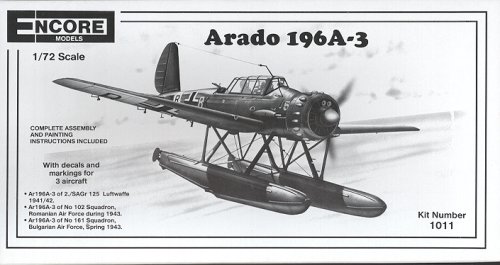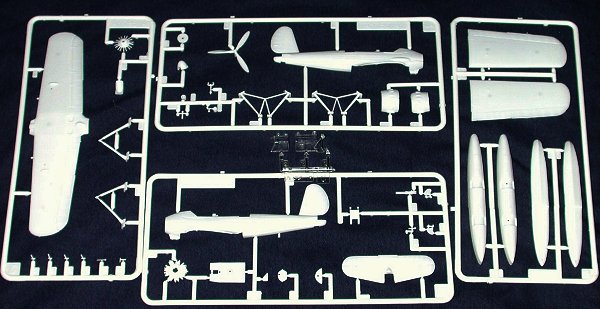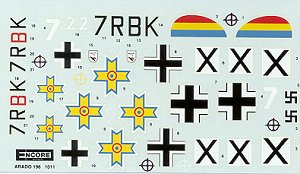
|
KIT: |
Encore 1/72 Ar-196 |
|
KIT # |
1011 |
|
PRICE: |
$6.98 |
|
DECALS: |
Three options |
|
REVIEWER: |
Scott Van Aken |
|
NOTES: |
Reboxed Heller kit |

|
HISTORY |
Development started in fall of 1936 as a replacement of the obsolete Heinkel Bi-planes used these days. The first prototypes of the all metal planes flew in summer of 1937 showing its superiority over the competing Focke-Wulf design. Full scale production started in 1939.
The Arado Ar 196 was relative heavy armed for a sea based reconnaissance plane and with its agility it was able ot protect itself against land based fighters in the early stage of the war. Besides its use on larger Kriegsmarine ships and auxiliary cruisers, the aircraft also operated in coastal patrols - one remarkable event was the capture of the British submarine H.M.S. Shark in May 1940.
Over 500 Ar 196 were build at Arado, Société Nationale de Construction Aèronautique in France and Fokker in the Netherlands between 1939 and 1944. At least three survive; one in Bulgaria and two in the US at NAS Willow Grove and the Smithsonian collection.
|
THE KIT |

Though boxed by Encore, this is a Heller mold that was produced in Mexico with a better decal sheet than what normally comes with a Heller kit. The kit is molded in white plastic, which makes finding glitches extremely difficult, and is of the standard raised panel variety that was the norm in the late 1970s and early 1980s when Heller was cranking out new kits each month. Despite their age, the molds are in pretty good condition. There are the usual ejector pin marks on some parts, but no sink areas and very little flash. The biggest problem was that the lower part of the floats seemed deformed and lacking a bit of plastic around the sprue attachment points. The fuselage halves were also a bit warped, but nothing major that can't be fixed by sectional gluing.
Cockpit consists of a seat, control stick, rudder pedals and two instrument panels with raised detail. The back seater gets a seat and a twin mount machine gun. No other options are provided. There are small bomb racks molded on the lower wing, but no bombs. Transparencies are nice and clear, though not crystal clear. It is nice that rudders are provided in the up and stowed position, so doing a water-borne diorama will require a touch of modification of these parts.
T he
instructions are better than the Heller one in that it is printed in
English and so you don't need some sort of conversion chart to figure out
what colors are needed. Colors are listed in RLM numbers where
appropriate. I should point out that the inside of the engine cowling is
listed as RLM 66 when it should probably be RLM 02. Markings are provided
for three aircraft, all in RLM 72 over RLM 65. First is a Luftwaffe
aircraft from 2./SaGr 125 in the Aegean during 1941/2. It has a
white fuselage band and yellow under the cowling, wing tips and on the
spinner tip. There is also a Romanian and Bulgarian Ar-196. Both have
yellow fuselage bands, while the Romanian one has yellow under the wing
tips, cowling and on the spinner. The Bulgarian rudder stripes will have
to be painted on. My decal sheet was well printed, but the red was
slightly off register causing problems with the Romanian insignia.
he
instructions are better than the Heller one in that it is printed in
English and so you don't need some sort of conversion chart to figure out
what colors are needed. Colors are listed in RLM numbers where
appropriate. I should point out that the inside of the engine cowling is
listed as RLM 66 when it should probably be RLM 02. Markings are provided
for three aircraft, all in RLM 72 over RLM 65. First is a Luftwaffe
aircraft from 2./SaGr 125 in the Aegean during 1941/2. It has a
white fuselage band and yellow under the cowling, wing tips and on the
spinner tip. There is also a Romanian and Bulgarian Ar-196. Both have
yellow fuselage bands, while the Romanian one has yellow under the wing
tips, cowling and on the spinner. The Bulgarian rudder stripes will have
to be painted on. My decal sheet was well printed, but the red was
slightly off register causing problems with the Romanian insignia.
|
CONCLUSIONS |
Other than the white plastic, easier to read instructions and improved decals, this is exactly the same as the Heller kit. I built one of these some 20 years ago and it lasted quite a while before succumbing to age and too many accidents! It makes into a nice model and your only other choice in this scale is the Airfix kit, which may not be that easy to find.
If you would like your product reviewed fairly and quickly by a site that has nearly 250,000 visitors a month, please contact me or see other details in the Note to Contributors.